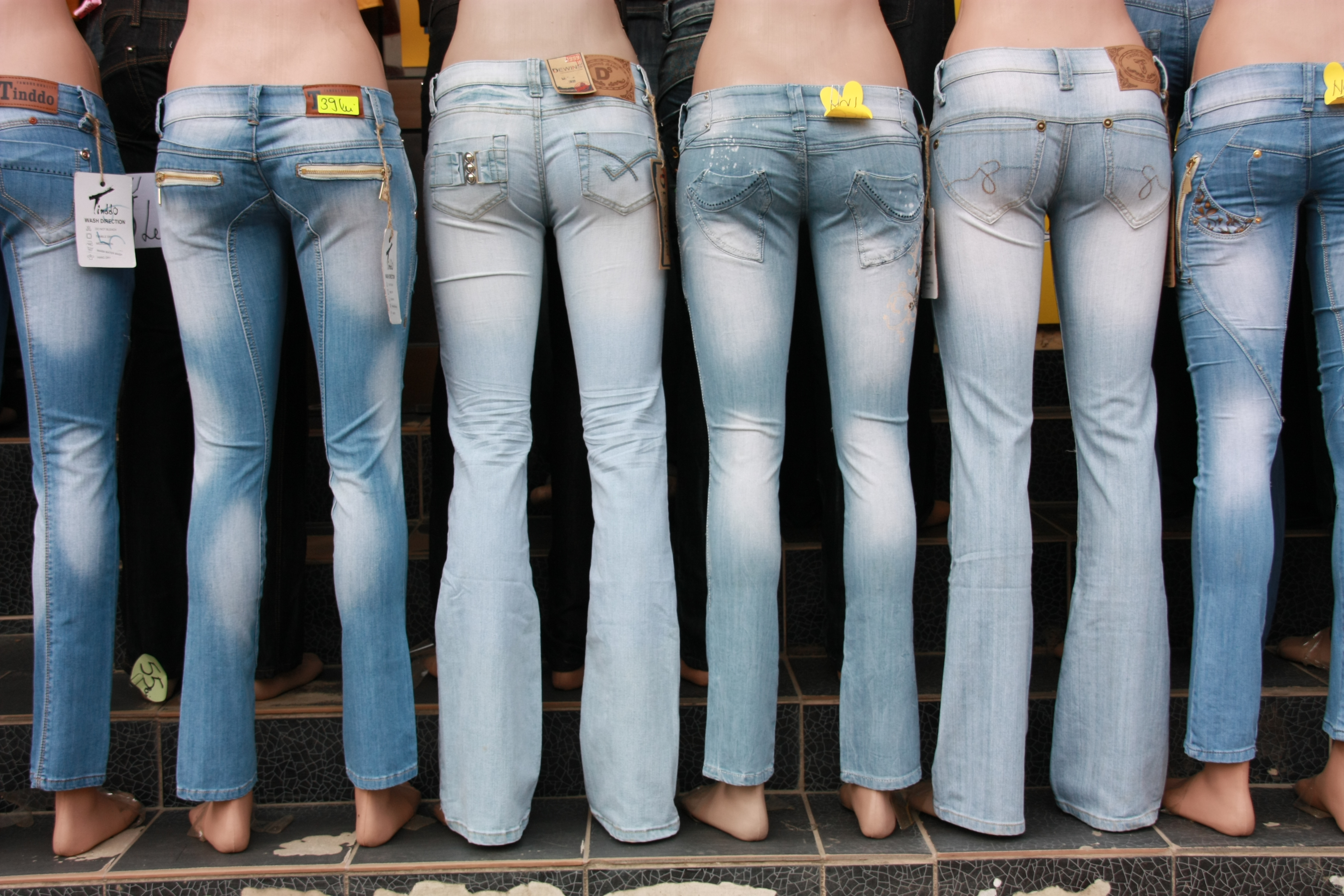|
Stonewash
Stone washing is a textile manufacturing process used to give a newly manufactured cloth garment a worn-in (or worn-out) appearance. Stone-washing also helps to increase the softness and flexibility of otherwise stiff and rigid fabrics such as canvas and denim. The process uses large stones to roughen up the fabric being processed. The garments are placed in a large horizontal industrial clothes washer that is also filled with large stones. As the wash cylinder rotates, the cloth fibers are repeatedly pounded and beaten as the tumbling stones ride up the paddles inside the drum and fall back down onto the fabric. A number of people and organizations have claimed to have invented stone-washing. According to Levi Strauss & Co., Donald Freeland, an employee of the Great Western Garment Company (later acquired by Levi's), invented "stone-washing" denim in the 1950s. Inventor Claude Blankiet has also been credited with having invented the technique in the 1970s. The jeans company ... [...More Info...] [...Related Items...] OR: [Wikipedia] [Google] [Baidu] |
Jeans
Jeans are a type of pants or trousers made from denim or dungaree cloth. Often the term "jeans" refers to a particular style of trousers, called "blue jeans", with copper-riveted pockets which were invented by Jacob W. Davis in 1871 and patented by Jacob W. Davis and Levi Strauss on May 20, 1873. Prior to the patent, the term "blue jeans" had been long in use for various garments (including trousers, overalls, and coats), constructed from blue-colored denim. "Jean" also references a (historic) type of sturdy cloth commonly made with a cotton warp and wool weft (also known as "Virginia cloth"). Jean cloth can be entirely cotton as well, similar to denim. Originally designed for miners, modern jeans were popularized as casual wear by Marlon Brando and James Dean in their 1950s films, particularly ''The Wild One'' and ''Rebel Without a Cause'', leading to the fabric becoming a symbol of rebellion among teenagers, especially members of the greaser subculture. From the 1960s onwar ... [...More Info...] [...Related Items...] OR: [Wikipedia] [Google] [Baidu] |
Mannequin With Jeans
A mannequin (also called a dummy, lay figure, or dress form) is a doll, often articulated, used by artists, tailors, dressmakers, window dressers and others, especially to display or fit clothing and show off different fabrics and textiles. Previously, the English term referred to human models and muses (a meaning which it still retains in French and other European languages); the meaning as a dummy dating from the start of World War II. Life-sized mannequins with simulated airways are used in the teaching of first aid, CPR, and advanced airway management skills such as tracheal intubation. During the 1950s, mannequins were used in nuclear tests to help show the effects of nuclear weapons on humans. Also referred to as mannequins are the human figures used in computer simulation to model the behavior of the human body. ''Mannequin'' comes from the French word ', which had acquired the meaning "an artist's jointed model", which in turn came from the Flemish word ', meaning "l ... [...More Info...] [...Related Items...] OR: [Wikipedia] [Google] [Baidu] |
Counterculture
A counterculture is a culture whose values and norms of behavior differ substantially from those of mainstream society, sometimes diametrically opposed to mainstream cultural mores.Eric Donald Hirsch. ''The Dictionary of Cultural Literacy''. Houghton Mifflin. . (1993) p. 419. "Members of a cultural protest that began in the U.S. In the 1960s and Europe before fading in the 1970s... fundamentally a cultural rather than a Protest, political protest." A countercultural movement expresses the ethos and aspirations of a specific population during a well-defined era. When oppositional forces reach Critical mass (sociodynamics), critical mass, countercultures can trigger dramatic cultural changes. Prominent examples of countercultures in the Western world include the Levellers (1645–1650), Bohemianism (1850–1910), the more fragmentary counterculture of the Beat Generation (1944–1964), followed by the globalized counterculture of the 1960s (1964–1974). Definition and characteris ... [...More Info...] [...Related Items...] OR: [Wikipedia] [Google] [Baidu] |
Potassium Permanganate
Potassium permanganate is an inorganic compound with the chemical formula KMnO4. It is a purplish-black crystalline salt, that dissolves in water as K+ and , an intensely pink to purple solution. Potassium permanganate is widely used in the chemical industry and laboratories as a strong oxidizing agent, and also as a medication for dermatitis, for cleaning wounds, and general disinfection. It is on the World Health Organization's List of Essential Medicines. In 2000, worldwide production was estimated at 30,000 tonnes. Properties Potassium permanganate is the potassium salt of the tetrahedral transition metal oxo complex permanganate, in which four O2- ligands are bound to a manganese(VII) center. Structure KMnO4 forms orthorhombic crystals with constants: ''a'' = 910.5 pm, ''b'' = 572.0 pm, ''c'' = 742.5 pm. The overall motif is similar to that for barium sulfate, with which it forms solid solutions. In the solid (as in solution), each MnO4− centre is t ... [...More Info...] [...Related Items...] OR: [Wikipedia] [Google] [Baidu] |
Rifle (fashion)
{{fashion-stub ...
Rifle is an Italian clothing company founded in 1958 in Prato. It was most famous for their jeans during the 1980s, especially in the USSR, Bulgaria, Poland, and Czechoslovakia. It was also very popular in Switzerland, UK, Israel , the Netherlands and Colombia between 1975 and 1990. There are upscale lines of Rifle Jeans, called Super Rifle, Golden Rifle and Royal Rifle. External links Official site Clothing brands of Italy Fashion accessory brands Rifle Rifle A rifle is a long-barreled firearm designed for accurate shooting, with a barrel that has a helical pattern of grooves ( rifling) cut into the bore wall. In keeping with their focus on accuracy, rifles are typically designed to be held with ... [...More Info...] [...Related Items...] OR: [Wikipedia] [Google] [Baidu] |
Rhinestone
A rhinestone, paste or diamante is a diamond simulant originally made from rock crystal but since the 19th century from crystal glass or polymers such as acrylic. Original Originally, rhinestones were rock crystals gathered from the river Rhine, hence the name, although some were also found in areas like the Alps, but today the name "rhinestone" applies only to varieties of lead glass known as crystal glass. The availability was greatly increased in the 18th century when the Alsatian jeweller Georg Friedrich Strass had the idea to imitate diamonds by coating the lower side of lead glass with metal powder. Hence, rhinestones are called ''strass'' in many European languages. As opposed to the classic rhinestones, which had a metal powder coating on the bottom side only, several companies have opted to mass-produce iridescent lead glass, by reducing the metal coating thickness and applying it uniformly, not using metal powder with a binder but by applying various forms of met ... [...More Info...] [...Related Items...] OR: [Wikipedia] [Google] [Baidu] |
Punk Fashion
Punk fashion is the clothing, hairstyles, cosmetics, jewellery, and body modifications of the punk counterculture. Punk fashion varies widely, ranging from Vivienne Westwood designs to styles modeled on bands like The Exploited to the dressed-down look of North American hardcore. The distinct social dress of other subcultures and art movements, including glam rock, skinheads, greasers, and mods have influenced punk fashion. Punk fashion has likewise influenced the styles of these groups, as well as those of popular culture. Many punks use clothing as a way of making a statement. Punk fashion has long been commercialized, with well-established fashion designers like Zandra Rhodes, Thierry Mugler, Jean Paul Gaultier, Stephen Sprouse, and Anna Sui using punk elements in their production and the first punk-influenced fashion spreads appearing in mainstream fashion magazines as early as 1976. The early, pre-fame work of designer Vivienne Westwood helped pioneer the look of early Brit ... [...More Info...] [...Related Items...] OR: [Wikipedia] [Google] [Baidu] |
Guess Inc
A guess (or an act of guessing) is a swift conclusion drawn from data directly at hand, and held as probable or tentative, while the person making the guess (the guesser) admittedly lacks material for a greater degree of certainty. A guess is also an unstable answer, as it is "always putative, fallible, open to further revision and interpretation, and validated against the horizon of possible meanings by showing that one interpretation is more probable than another in light of what we already know". In many of its uses, "the meaning of guessing is assumed as implicitly understood",Mark Tschaepe, "Gradations of Guessing: Preliminary Sketches and Suggestions", in John R. Shook, ''Contemporary Pragmatism'' Volume 10, Number 2, (December 2013), p. 135-154. and the term is therefore often used without being meticulously defined. Guessing may combine elements of deduction, induction, abduction, and the purely random selection of one choice from a set of given options. Guessing may also ... [...More Info...] [...Related Items...] OR: [Wikipedia] [Google] [Baidu] |
Camouflage
Camouflage is the use of any combination of materials, coloration, or illumination for concealment, either by making animals or objects hard to see, or by disguising them as something else. Examples include the leopard's spotted coat, the battledress of a modern soldier, and the leaf-mimic katydid's wings. A third approach, motion dazzle, confuses the observer with a conspicuous pattern, making the object visible but momentarily harder to locate, as well as making general aiming easier. The majority of camouflage methods aim for crypsis, often through a general resemblance to the background, high contrast disruptive coloration, eliminating shadow, and countershading. In the open ocean, where there is no background, the principal methods of camouflage are transparency, silvering, and countershading, while the ability to produce light is among other things used for counter-illumination on the undersides of cephalopods such as squid. Some animals, such as chameleons and o ... [...More Info...] [...Related Items...] OR: [Wikipedia] [Google] [Baidu] |
Cut-off
A cut-off, battle jacket, battle vest or kutte in heavy metal subcultures, is a type of vest or jacket which originated in the U.S. military, specifically the Army Air Corps, where pilots and other aviation personnel would collect patches or other insignia to put on regulation bomber jackets or flight suits. The practice continued within the biker subculture and auto racing subculture and later found popularity in punk and various heavy metal subcultures. Biker, auto racing, metal and punk subcultures differ in how the garment is prepared, what decorations are applied, and how this is done. Cut-offs are usually made from leather or denim jackets with their sleeves removed, or cut very short, and often adorned with patches, badges and painted artwork that display motorcycle club affiliations known as colours, or alternatively band names, political affiliations, beliefs, or sexual acts performed. In the 1970s and 1980s, cut-offs were almost always blue denim. Thrash metal fans f ... [...More Info...] [...Related Items...] OR: [Wikipedia] [Google] [Baidu] |
Bleach
Bleach is the generic name for any chemical product that is used industrially or domestically to remove color (whitening) from a fabric or fiber or to clean or to remove stains in a process called bleaching. It often refers specifically, to a dilute solution of sodium hypochlorite, also called "liquid bleach". Many bleaches have broad spectrum bactericidal properties, making them useful for disinfecting and sterilizing. They are used in swimming pool sanitation to control bacteria, viruses, and algae, and in many places where sterile conditions are required. They are also used in many industrial processes, notably in the bleaching of wood pulp. Bleaches also have other minor uses like removing mildew, killing weeds, and increasing the longevity of cut flowers. Bleaches work by reacting with many colored organic compounds, such as natural pigments, and turning them into colorless ones. While most bleaches are oxidizing agents (chemicals that can remove electrons from other ... [...More Info...] [...Related Items...] OR: [Wikipedia] [Google] [Baidu] |










